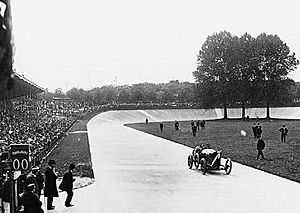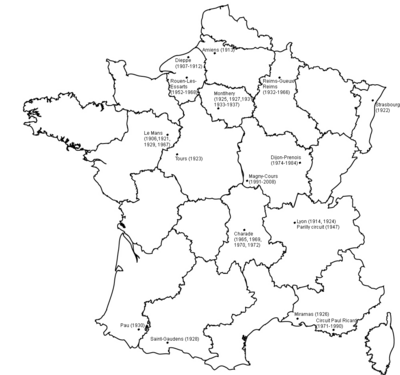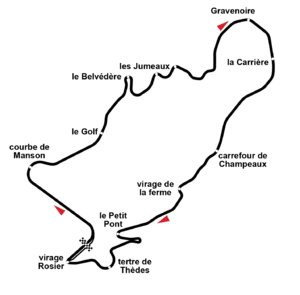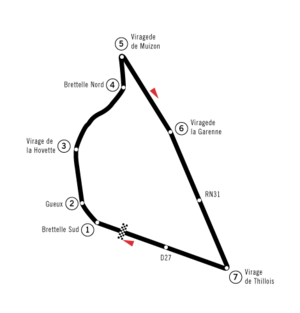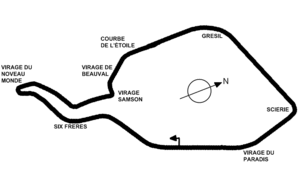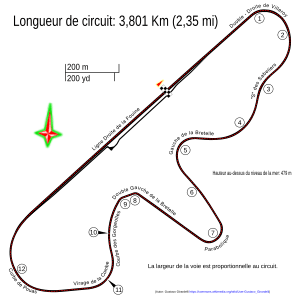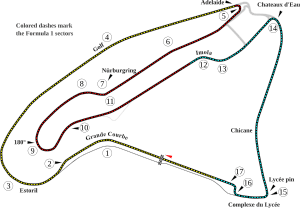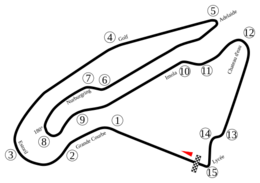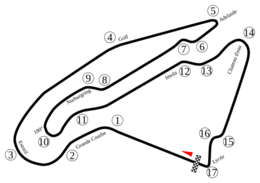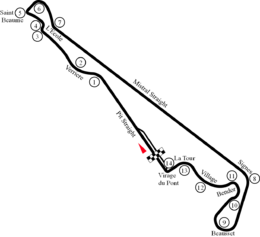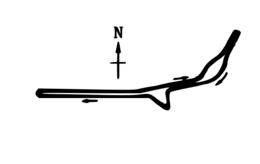French Grand Prix facts for kids
| Circuit Paul Ricard | |
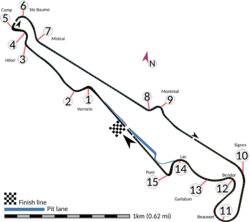 |
|
| Race information | |
|---|---|
| Number of times held | 90 |
| First held | 1906 |
| Last held | 2022 |
| Most wins (drivers) | |
| Most wins (constructors) | |
| Circuit length | 5.842 km (3.630 mi) |
| Race length | 309.690 km (192.432 mi) |
| Laps | 53 |
| Last race (2022) | |
| Pole position | |
|
|
| Podium | |
|
|
| Fastest lap | |
|
|
The French Grand Prix (which means "Great Prize of France" in French) is a famous car race. It is part of the yearly Formula One World Championship. This race is one of the oldest motor races in the world. It was even the very first "Grand Prix" race ever!
The race stopped for a while after 2008 because of money problems. But it came back to the Formula One calendar in 2018. The Circuit Paul Ricard hosted the race then. However, it was removed from the calendar again after 2022.
The French Grand Prix has been held at many different places. Over its long history, 16 different race tracks have been used. This is a lot, showing how much the race has moved around!
History of the Race
How it All Started
France was one of the first countries to have car races. The very first car race was held on July 22, 1894. It was called the Paris to Rouen Horseless Carriages Contest. This race was organized by the Automobile Club de France (ACF).
The race was about 126 kilometers (78 miles) long. Count Jules-Albert de Dion won it in his steam-powered car. He finished in just under 7 hours. After this, many other races started in Paris. They went to different cities in France and other parts of Europe.
The early races were held on public dirt roads. These roads were not always closed to people. In 1903, a race from Paris to Madrid was a disaster. Many people were hurt, and some even died. This happened because cars were going very fast (up to 140 km/h or 87 mph). The roads were dusty, and people stood too close. After this, the French government stopped races on open public roads.
The First "Grand Prix" Race
Racing on Closed Roads
The first official French Grand Prix race happened on June 26, 1906. It was open to racers from all over the world. The race was held in Sarthe, France. The name "Grand Prix" means "Great Prize." This was because the winner received a large prize of 45,000 French francs. This was a lot of money back then!
Early French Grands Prix were held on public roads. These roads were closed off for the race. They were usually near towns in northern and central France. The race often moved to different towns each year. Places like Le Mans, Dieppe, and Lyon hosted the event. The Dieppe circuit was very dangerous. Several people were hurt or died there.
The 1906 race was the first ever to be called "Grand Prix." It was run on a very fast 106-kilometer (66-mile) circuit. This circuit was east of Le Mans. The winner was Ferenc Szisz from Hungary. He drove a Renault car. The race lasted 12 hours on a dirt road! Even so, the fastest cars went over 118 km/h (73 mph).
The 1914 race near Lyon was very exciting. It was a tough battle between French Peugeot cars and German Mercedes cars. The Mercedes cars won, finishing in the top three spots. This was a big win for them.
After World War I, the Grand Prix returned in 1921. American Jimmy Murphy won that race. In 1922, Bugatti cars raced for the first time. The race was near Strasbourg. It rained, and the track was very muddy.
France's First Special Race Tracks
In 1925, France built its first special race track. It was called Montlhéry. It was located south of Paris. This track was 12.3 kilometers (7.7 miles) long. It had steep concrete turns and modern facilities. These included pit garages and grandstands.
Montlhéry hosted the Grand Prix de l'ACF in 1925. This was part of the first-ever World Manufacturers' Championship. Many people came to watch the fast cars. Another track, Miramas, was finished in 1926. It also hosted the Grand Prix that year.
The 1930 French Grand Prix was held in Pau. A special supercharged Blower Bentley car raced there. It was much bigger than the other cars. The Bentley was very fast on the long straight parts of the track. It could go 208 km/h (130 mph)!
From 1933 to 1937, Montlhéry was the only place for the French Grand Prix. In 1934, Mercedes-Benz cars returned to Grand Prix racing. Their new cars were very advanced. They seemed to float over the bumpy track. The German "Silver Arrows" cars were very fast.
Reims, Rouen, and Charade Circuits
The French Grand Prix returned to the Reims-Gueux circuit in 1938 and 1939. The German Silver Arrows cars continued to win. After World War II, the race came back in 1947. Then, it went back to Reims-Gueux.
In 1950, the Formula One World Championship began. The French Grand Prix was one of the first races. Juan Manuel Fangio from Argentina won in 1950 and 1951. The 1951 race was the longest Formula One race ever.
The race was held at the Rouen-Les-Essarts circuit in 1952. Rouen was a very fast track. In 1953, the Reims circuit was made even faster. The 1953 race was a classic. Fangio and Mike Hawthorn had a close battle. Hawthorn won.
In 1954, Mercedes returned to racing again. Fangio and his teammate Karl Kling won easily. The French Grand Prix was canceled in 1955. This was because of a big accident at the Le Mans race.
The race continued at Reims until 1966. In 1965, the race was held at the Charade Circuit. This track was very twisty and challenging. In 1968, a serious accident happened at Rouen-Les-Essarts. A French driver, Jo Schlesser, was killed. After this, Formula One stopped racing on public roads.
Modern Tracks: Le Castellet and Dijon-Prenois
Formula One returned to Paul Ricard in 1973. This track is in Le Castellet, near Marseille. It was a new, modern facility. It had wide tracks and safe run-off areas. Many famous French drivers learned to race here.
The race also took place at the Dijon circuit in 1974. Paul Ricard and Dijon then took turns hosting the race until 1984. The 1979 race at Dijon was very famous. Two drivers, René Arnoux and Gilles Villeneuve, had an amazing battle for second place. They raced very close, even touching wheels!
The 1979 race was also special because it was the first time a Formula One car with a turbo-charged engine won. French driver Jean-Pierre Jabouille won for Renault. In 1981, Alain Prost won his first of many races. He would become a four-time world champion.
From 1985 to 1990, Paul Ricard was the only host. A shorter version of the track was used after 1986. This was because of a fatal crash during a test session. Prost won the last three races there. In 1990, he made a late comeback to win.
Magny-Cours (1991-2008)
In 1991, the race moved to the Magny-Cours track. It stayed there for 17 years. This was the seventh different track to host the French Grand Prix.
Some highlights at Magny-Cours include Prost's last win in France in 1993. Michael Schumacher also won his 2002 championship there very early in the season. The race faced money problems in 2004 and 2005.
In 2007, it was announced that the 2008 French Grand Prix would be paused. This was due to money issues and the track's remote location. However, funding was found for 2008. This made the 2008 race the last French Grand Prix for 10 years.
The Race Takes a Break
After 2008, the French Grand Prix was not held for several years. There were talks about bringing it back. Different places were suggested for a new track. But none of these plans worked out. So, there was no French Grand Prix in 2010 and 2011.
Many French drivers have won the French Grand Prix. Alain Prost won the race six times. He won at three different tracks. But German driver Michael Schumacher won eight times. This is the most wins for any driver at this Grand Prix.
Return to Le Castellet
In December 2016, it was confirmed that the French Grand Prix would return. It came back in 2018 at the Circuit Paul Ricard. The track had a contract to host the race until 2022.
The 2020 race was canceled because of the COVID-19 pandemic. But the race returned for the 2021 season.
The French Grand Prix was not on the 2023 calendar. The organizers said they want to share the race slot with other Grands Prix. This means it might not be held every year.
Winners of the French Grand Prix
Drivers with Multiple Wins
Drivers in bold are racing in Formula One now. A yellow background means the event was part of the pre-war European Championship. A green background means the event was part of the pre-war World Manufacturers' Championship. A pink background means the event was not part of the Formula One World Championship or other championships mentioned.
| Wins | Driver | Years |
|---|---|---|
| 8 | 1994, 1995, 1997, 1998, 2001, 2002, 2004, 2006 | |
| 6 | 1981, 1983, 1988, 1989, 1990, 1993 | |
| 5 | 1931, 1934, 1937, 1947, 1949 | |
| 4 | 1950, 1951, 1954, 1957 | |
| 1986, 1987, 1991, 1992 | ||
| 3 | 1960, 1966, 1967 | |
| 1969, 1971, 1972 | ||
| 2 | 1912, 1913 | |
| 1908, 1914 | ||
| 1907, 1922 | ||
| 1925, 1927 | ||
| 1928, 1929 | ||
| 1924, 1933 | ||
| 1936, 1948 | ||
| 1953, 1958 | ||
| 1962, 1964 | ||
| 1963, 1965 | ||
| 1973, 1974 | ||
| 1975, 1984 | ||
| 1977, 1978 | ||
| 2018, 2019 | ||
| 2021, 2022 | ||
| Sources: | ||
- Louis Chiron won the 1931 race, but shared the win with Achille Varzi.
- Juan Manuel Fangio won the 1951 race, but shared the win with Luigi Fagioli.
Teams with Multiple Wins
Teams in bold are racing in Formula One now. A yellow background means the event was part of the pre-war European Championship. A green background means the event was part of the pre-war World Manufacturers' Championship. A pink background means the event was not part of the Formula One World Championship or other championships mentioned.
| Wins | Constructor | Years won |
|---|---|---|
| 17 | 1952, 1953, 1956, 1958, 1959, 1961, 1968, 1975, 1990, 1997, 1998, 2001, 2002, 2004, 2006, 2007, 2008 | |
| 8 | 1980, 1986, 1987, 1991, 1992, 1993, 1996, 2003 | |
| 7 | 1963, 1965, 1970, 1973, 1974, 1977, 1978 | |
| 1908, 1914, 1935, 1938, 1954, 2018, 2019 | ||
| 6 | 1926, 1928, 1929, 1930, 1931, 1936 | |
| 1924, 1932, 1934, 1948, 1950, 1951 | ||
| 1906, 1979, 1981, 1982, 1983, 2005 | ||
| 5 | 1976, 1984, 1988, 1989, 2000 | |
| 4 | 1964, 1966, 1967, 1985 | |
| 2 | 1912, 1913 | |
| 1907, 1922 | ||
| 1925, 1927 | ||
| 1947, 1949 | ||
| 1933, 1957 | ||
| 1971, 1972 | ||
| 1994, 1995 | ||
| 2021, 2022 | ||
| Sources: | ||
Engine Manufacturers with Multiple Wins
Manufacturers in bold are racing in Formula One now. A yellow background means the event was part of the pre-war European Championship. A green background means the event was part of the pre-war World Manufacturers' Championship. A pink background means the event was not part of the Formula One World Championship or other championships mentioned.
| Wins | Manufacturer | Years won |
|---|---|---|
| 17 | 1952, 1953, 1956, 1958, 1959, 1961, 1968, 1975, 1990, 1997, 1998, 2001, 2002, 2004, 2006, 2007, 2008 | |
| 11 | 1969, 1970, 1971, 1972, 1973, 1974, 1976, 1977, 1978, 1980, 1994 | |
| 1906, 1979, 1981, 1982, 1983, 1991, 1992, 1993, 1995, 1996, 2005 | ||
| 8 | 1908, 1914, 1935, 1938, 1954, 2000, 2018, 2019 | |
| 6 | 1926, 1928, 1929, 1930, 1931, 1936 | |
| 1924, 1932, 1934, 1948, 1950, 1951 | ||
| 5 | 1986, 1987, 1988, 1989, 2021 | |
| 4 | 1960, 1963, 1964, 1965 | |
| 2 | 1912, 1913 | |
| 1907, 1922 | ||
| 1925, 1927 | ||
| 1947, 1949 | ||
| 1933, 1957 | ||
| 1966, 1967 | ||
| 1985, 2003 | ||
| Sources: | ||
Winners by Year
A yellow background means the event was part of the pre-war European Championship. A green background means the event was part of the pre-war World Manufacturers' Championship. A pink background means the event was not part of the Formula One World Championship or other championships mentioned.
| Year | Driver | Constructor | Location | Report |
|---|---|---|---|---|
| 1906 | Renault | Le Mans | Report | |
| 1907 | Fiat | Dieppe | Report | |
| 1908 | Mercedes | Report | ||
| 1909 – 1911 |
Not held | |||
| 1912 | Peugeot | Dieppe | Report | |
| 1913 | Peugeot | Amiens | Report | |
| 1914 | Mercedes | Lyon | Report | |
| 1915 – 1920 |
Not held due to World War I | |||
| 1921 | Duesenberg | Le Mans | Report | |
| 1922 | Fiat | Strasbourg | Report | |
| 1923 | Sunbeam | Tours | Report | |
| 1924 | Alfa Romeo | Lyon | Report | |
| 1925 | Delage | Montlhéry | Report | |
| 1926 | Bugatti | Miramas | Report | |
| 1927 | Delage | Montlhéry | Report | |
| 1928 | Bugatti | Saint-Gaudens | Report | |
| 1929 | Bugatti | Le Mans | Report | |
| 1930 | Bugatti | Pau | Report | |
| 1931 | Bugatti | Montlhéry | Report | |
| 1932 | Alfa Romeo | Reims | Report | |
| 1933 | Maserati | Montlhéry | Report | |
| 1934 | Alfa Romeo | Report | ||
| 1935 | Mercedes-Benz | Report | ||
| 1936 | Bugatti | Report | ||
| 1937 | Talbot | Report | ||
| 1938 | Mercedes | Reims | Report | |
| 1939 | Auto Union | Report | ||
| 1940 – 1946 |
Not held due to World War II | |||
| 1947 | Talbot-Lago | Lyon-Parilly | Report | |
| 1948 | Alfa Romeo | Reims | Report | |
| 1949 | Talbot-Lago | Report | ||
| Delahaye | Saint-Gaudens | Report | ||
| 1950 | Alfa Romeo | Reims | Report | |
| 1951 | Alfa Romeo | Report | ||
| 1952 | Ferrari | Rouen | Report | |
| 1953 | Ferrari | Reims | Report | |
| 1954 | Mercedes | Report | ||
| 1955 | Not held due to the 1955 Le Mans disaster | |||
| 1956 | Ferrari | Reims | Report | |
| 1957 | Maserati | Rouen | Report | |
| 1958 | Ferrari | Reims | Report | |
| 1959 | Ferrari | Report | ||
| 1960 | Cooper-Climax | Report | ||
| 1961 | Ferrari | Report | ||
| 1962 | Porsche | Rouen | Report | |
| 1963 | Lotus-Climax | Reims | Report | |
| 1964 | Brabham-Climax | Rouen | Report | |
| 1965 | Lotus-Climax | Charade | Report | |
| 1966 | Brabham-Repco | Reims | Report | |
| 1967 | Brabham-Repco | Le Mans | Report | |
| 1968 | Ferrari | Rouen | Report | |
| 1969 | Matra-Ford | Charade | Report | |
| 1970 | Lotus-Ford | Report | ||
| 1971 | Tyrrell-Ford | Paul Ricard | Report | |
| 1972 | Tyrrell-Ford | Charade | Report | |
| 1973 | Lotus-Ford | Paul Ricard | Report | |
| 1974 | Lotus-Ford | Dijon | Report | |
| 1975 | Ferrari | Paul Ricard | Report | |
| 1976 | McLaren-Ford | Report | ||
| 1977 | Lotus-Ford | Dijon | Report | |
| 1978 | Lotus-Ford | Paul Ricard | Report | |
| 1979 | Renault | Dijon | Report | |
| 1980 | Williams-Ford | Paul Ricard | Report | |
| 1981 | Renault | Dijon | Report | |
| 1982 | Renault | Paul Ricard | Report | |
| 1983 | Renault | Report | ||
| 1984 | McLaren-TAG | Dijon | Report | |
| 1985 | Brabham-BMW | Paul Ricard | Report | |
| 1986 | Williams-Honda | Report | ||
| 1987 | Williams-Honda | Report | ||
| 1988 | McLaren-Honda | Report | ||
| 1989 | McLaren-Honda | Report | ||
| 1990 | Ferrari | Report | ||
| 1991 | Williams-Renault | Magny-Cours | Report | |
| 1992 | Williams-Renault | Report | ||
| 1993 | Williams-Renault | Report | ||
| 1994 | Benetton-Ford | Report | ||
| 1995 | Benetton-Renault | Report | ||
| 1996 | Williams-Renault | Report | ||
| 1997 | Ferrari | Report | ||
| 1998 | Ferrari | Report | ||
| 1999 | Jordan-Mugen-Honda | Report | ||
| 2000 | McLaren-Mercedes | Report | ||
| 2001 | Ferrari | Report | ||
| 2002 | Ferrari | Report | ||
| 2003 | Williams-BMW | Report | ||
| 2004 | Ferrari | Report | ||
| 2005 | Renault | Report | ||
| 2006 | Ferrari | Report | ||
| 2007 | Ferrari | Report | ||
| 2008 | Ferrari | Report | ||
| 2009 – 2017 |
Not held | |||
| 2018 | Mercedes | Paul Ricard | Report | |
| 2019 | Mercedes | Report | ||
| 2020 | Not held due to the COVID-19 pandemic | |||
| 2021 | Red Bull Racing-Honda | Paul Ricard | Report | |
| 2022 | Red Bull Racing-RBPT | Report | ||
| Sources: | ||||
Races Sometimes Called French Grand Prix
Before 1906, some races in France were later called "Grands Prix de l'Automobile Club de France" by the French media. This made it seem like the French Grand Prix was the oldest race in the world. Here are some of those early races and their winners.
| Year | Race Title | Driver | Constructor | Location | Report |
|---|---|---|---|---|---|
| 1895 | Paris–Bordeaux–Paris race | Peugeot | Paris–Bordeaux–Paris | Report | |
| 1896 | Paris–Marseille–Paris race | Panhard | Paris–Marseille–Paris | Report | |
| 1898 | Paris–Amsterdam–Paris race | Panhard | Paris–Amsterdam–Paris | Report | |
| 1899 | Tour de France | Panhard | Paris–Paris | Report | |
| 1900 | Paris–Toulouse–Paris race | Mors | Paris–Toulouse–Paris | Report | |
| 1901 | Paris–Berlin race | Mors | Paris–Berlin | Report | |
| 1902 | Paris–Vienna race | Renault | Paris–Vienna | Report | |
| 1903 | Paris–Madrid race | Mors | Paris–Madrid | Report | |
| Source: | |||||
See also
 In Spanish: Gran Premio de Francia para niños
In Spanish: Gran Premio de Francia para niños


